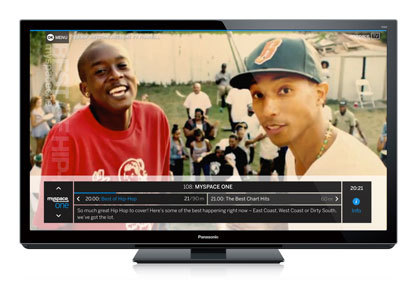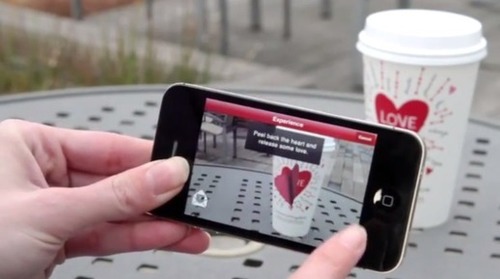Starbucks is giving its augmented reality mobile app a little bit more love. Literally. As part of a new update, users of the company’s Cup Magic app can now point their phones at Starbucks Valentine’s Day-themed cups to see new, love-themed effects that appear to be happening on the cup itself.Besides looking neat, there is—of course—a business hook to get you to buy more than a cup of something for yourself. The app lets users buy and send digital Starbucks gift cards to friends that can be delivered on Valentine’s Day, as well as providing a way to send messages that require the recipient actually head to a Starbucks, buy a beverage, and aim it at one of the limited cups to see.
Via news.cnet.com

WELCOME You have found yourself in the terrific treasure trove that is Matmi's magical world of digital musings. Here is an ever growing collection of stories on digital media matters found while mooching through the web. Ranging from info on the latest games to new media design to trends in the digital marketing stratosphere (and the occasional post that just makes the Matmians' smile). - (curated by the eclectic tastes of the Mini Matmian ^SL...and a little help from his Matmian friends)
Tuesday, 28 February 2012
Starbucks’ augmented reality app gets all lovey dovey
Thursday, 23 February 2012
Petanque 3D - a Unity3D game from Matmi
Extremely cool game. Boules on the beach anyone?
How do you add the "Je ne sais quoi" of French chic to a promotional game? Je ne sais pas – but fortunately, other Matmians do …. and the result is a gorgeous looking game of classic French boules, Petanque 3D.
We've used the capabilities of Unity 3D to the max, to show off three French resorts where the levels are set, the game itself & the players (who are pretty good looking too, it has to be said). With single and multi-player options, 4 players and 3 levels of difficulty – plus setting up each shot for direction, height and power – Petanque is rather addictive.
It creeps up on you quietly, draws you in with that lovely French holiday feeling, a wonderfully laid-back soundtrack, stunning (sunny) graphics – and all of a sudden it's dark outside! Definitely one of our most evocative games.
PLAY: http://petanque3d.com/
Developed by Matmi
How do you add the "Je ne sais quoi" of French chic to a promotional game? Je ne sais pas – but fortunately, other Matmians do …. and the result is a gorgeous looking game of classic French boules, Petanque 3D.
We've used the capabilities of Unity 3D to the max, to show off three French resorts where the levels are set, the game itself & the players (who are pretty good looking too, it has to be said). With single and multi-player options, 4 players and 3 levels of difficulty – plus setting up each shot for direction, height and power – Petanque is rather addictive.
It creeps up on you quietly, draws you in with that lovely French holiday feeling, a wonderfully laid-back soundtrack, stunning (sunny) graphics – and all of a sudden it's dark outside! Definitely one of our most evocative games.
PLAY: http://petanque3d.com/
Developed by Matmi
Using Gamification to Build Your Business
February 22nd, 2012 by Sambo

A nice overview of what gamification can do for your brand and key questions to consider when implementing it.
via http://www.matmi.com/blog/using-gamification-to-build-your-business

From senet – a game played by Pharaohs in ancient Egypt – to the more modern phenomenon of Monopoly, games have a powerful draw. And now they are being partnered with business objectives. Yes, it is the hot startup buzzword of 2012: “Gamification”.
If the pairing of “business” and “games” immediately conjures thoughts of time wasted on Farmville, then it is time for you to take a second look. Gamification is all about injecting fun, recognition and/or competition into otherwise standard business relationships – using game-like techniques to motivate employees and customers to help you reach your goals.
Getting Started
Are you intrigued by the potential of gamification but at a loss as to what your next steps should be? Here are some questions to ask yourself:
A snippet of a post via www.odesk.com posted on January 18, 2012 in Small Businesses by Julia
- What are my objectives? Game elements should not be instituted haphazardly. Instead, figure out what it is you want people to do. Then evaluate which of those goals would most benefit from gamification.
- What would most appeal to my target audience? There is a big difference between what motivates a risk taker versus a more cautious personality. Take time to figure out what rewards would mean the most to your customers; if they dislike it, you could do more harm than good.
A nice overview of what gamification can do for your brand and key questions to consider when implementing it.
via http://www.matmi.com/blog/using-gamification-to-build-your-business
Tuesday, 21 February 2012
RedCritter Tracker – Gamifying the Work place

“It’s not all just about the badges. Project leaders can assign points to individual tasks (depending on difficulty or time it takes to complete). These points can then be saved up and exchanged in the RedCritter Tracker store to treat yourself to a pressie. These rewards were voted for by the Matmi staff. Take a look at the kind of thing they aim to spend their hard earned points on (not ashamed to say they are very geek friendly)”
Via www.orchard.co.uk
Tuesday, 14 February 2012
Gamification in Education

Mini Matmian:
The use of Gamification techniques within education is not on the horizon…it is already here. 6 months ago I highlighted the fact that the work teachers have been doing in classrooms across the globe for many years could easily be seen as a form of non-digital Gamification.
The use of Gamification techniques within education is not on the horizon…it is already here. 6 months ago I highlighted the fact that the work teachers have been doing in classrooms across the globe for many years could easily be seen as a form of non-digital Gamification.
The very practice of stickers, group leader-boards and reward systems that are already in place in so many primary school classrooms is already, in part, a form of gamification …
I then went on to mention how digital media could be used to augment the education process:
…add a bespoke system that also incorporates digital media (yes games are part of it) for multiple purposes that not only serve the individual pupil but also provide an accurate and easy way of tracking progress [for teachers) can only benefit the whole school environment.
All those many months ago I kept it brief. My experience as a former teacher meant that the topic was close to my heart and I knew that if I didn’t reign in my key-tapping fingers I would end up with a 3000 word essay.
As a supporter of the good gamification techniques can bring, I wanted to make one thing absolutely clear:
Sticking the same API or just shoe-horning badges in is NOT taking advantage of the power of game mechanics.
Read more...
Labels:
apps,
badges,
digital,
education,
eLearning,
gamification,
gamify,
gaming,
schools,
stickers,
technology,
trial shuttle.
Monday, 13 February 2012
6 Social Media Rules For Creating Brand Evangelists
6 Social Media Rules For Creating Brand Evangelists

Here are six new rules of engagement, based upon an analysis of brand successes, behavioral psychology, and trends in consumer marketing and the social context…….1. You See Numbers, People See ThemselvesMarketers who are trained in the nuances of insightful segmentation and consumer nuances seem to forget all that when marketing through social media. They blast one message to hundreds of thousands of people. Even millions. But creating a brand evangelist starts with a personal connection, and personal connections can’t be built with impersonal messaging. Acquiring giant quantities of friends makes this more difficult, but the growth of Big Data and customer intelligence solutions makes it possible.2. When People Share Values, They’ll Share A Lot MoreBrands today are complex, impressionistic constructions of product, performance, perceptions, and belief systems. More and more, brands are taking stands on social and even political issues; companies like Whole Foods and The Container Store, for example, are active members of the Conscious Capitalism movement.Brands can also share values through the choices they make in how they communicate. Style is substantive. Zappos is widely regarded as brilliantly adept at creating wildly devotional brand partisans, and the Twitter feed of its CEO, Tony Hsieh, is a large part of that.Here’s a perfect example of that; a Tweet he made last July. No sell, no offer, in fact, an anti-consumption message: Want happiness? Don’t buy more stuff—go on vacation!It was preceded by a Tweet about research on getting kids to consume more vegetables, and a quote from Ann Frank. This random glimpse into the mind of a CEO displays an emotional transparency that builds loyalty. You know that it wasn’t rubber-stamped by a Twitter Approval Sub-Committee.So social media is the ultimate platform for communicating your values and energizing people around them. Of course, you can’t satisfy everyone, but the process of creating brand acolytes means that you cannot be equally meaningful to everyone. Deal with it.3. Lameness Can’t Create LoyaltyHave you noticed how much social media is represented by Tweets and posts like this triteness display from McDonald’s:Morning! How’s everyone’s week going so far?24 Jan Favorite Retweet ReplyWould you want to be friends, and hang out with someone who always feels obligated to spout something, even when they have absolutely nothing of interest on their minds? So if you want to create evangelists, start with being excruciatingly demanding about every single thing you say. And how you say it.4. Real Friends Don’t Impose—Unless There’s a Good ReasonOffline relationships are the psychological model for brand “friendships.” Well, before you ask a friend for a favor, you think through the implications. How important is it to you? How difficult or emotionally fraught might it be your friend to act on your request? When does the request over-stretch the implicit boundaries of the relationship?Brands need to go through the same social calculus, but they seldom do. So a brand will ask you to forward something to a friend, or invite a friend to join a group, without really thinking through the implications. They are pushing hard, if not violating, the natural limits of the “friendship”—and then they are surprised when they don’t get the results they expected.To create evangelists who are ready, willing and able to use their social graphs to advance your brand, you need to develop some rules of reciprocity, and real customer intelligence about which of your current fans and friends are most likely to share. For example, those who have large networks, and high Klout scores, might be better evangelist than those who keep to themselves. But are you treating them all the same?5. Surprise Everyone, Including YourselfWe become emotionally attached to those who bring unexpected twists and surprises to our lives. That’s because disruptive surprise and intrigue release dopamine, which creates pleasure (and its evil cousin, addiction.) Insufficient novelty creates dopamine boredom.Surprise can be the way you say something (style) or what you give them as far as rewards or incentives go (content). It’s a rich area for innovation.Trouble is, many big brands see surprise as a risk, because it requires unexpected behaviors, which by definition, haven’t been done before and might be considered “off-brand.” Dopamine boredom is always safe. Hence the paradox of evangelists: to create them, you need to push on the limits of institutional norms. But if you do so, and surprise them and yourself in the process, you might actually find your dopamine will be flowing as much as theirs.6. Go Out Of Your Way For People, and They’ll Go Out of Their Way for YouOne of the most powerful ways to create evangelists is to behave with breathtaking responsiveness. Many are halfway there. Increasingly, more and more companies are turning to social media to address customer service issues. So we’re seeing tons of responses like this from Target:@XTEDDIX That’s frustrating! Thanks for letting us know. We’ll be passing your comments along to our Store Leadership team. MatthewBut what we’re not seeing are a lot of results. The average friend or fan is exposed to a torrent of problems, not solutions. So in the interests of being a responsive organization, brands can come across as customer-service train wrecks.Wouldn’t it be cool if a brand posted, each day, the resolution of its most triumphant, confounding, and amusing customer services issues.via Fast Company
Mini Matmian►
Cultivating a Social Media community who engage with a brand takes time, research and constant monitoring…alot each. It can be a daunting task to begin on this long road. These 6 points are a good place to start.
Each brands needs are unique in some way and it is important not to lose sight of this fact. Tailor your SM campaign to the needs of the brand with the needs of the customers you want to engage at the forefront of everything you do.
Be bold, be relevant, don’t be afraid to try things out and most importantly…be real. No one likes to feel they are talking to a automated robotic response. [end transmission]
Have you any tips to share with someone starting out their social media planning journey?
Labels:
6 rules,
brands,
cultivating,
engagement,
facebook,
fast company,
social media,
twitter
Interactive Artwork
Sick and tired of staring at Van Gogh’sStarry Night and being unable to manipulate it with your fingers? Enter: Greek digital artist Petros Vrellis and his interactive Starry Night animation.Using openFrameworks, Vrellis transformed Van Gogh’s masterpiece into an interactive painting capable of rearranging itself through touch-sensitive gestures. Additionally, background music responds to changes in the animation’s flow.You can learn more about it here.[colossal.]
via thedailywhat
Tuesday, 7 February 2012
Myspace announces partnership with Panasonic for Myspace TV
Myspace announces partnership with Panasonic for Myspace TV:

Myspace in their journey to become relevant again has partnered with Panasonic to launch a new service called Myspace TV.
Monday, 6 February 2012
NW1: Nerf War 1

The escalation:
It began with a single shot. One whistling tube of foam, flying through the air like a dive-bombing hawk. It’s target? An innocent Matmian’s head.
It began with a single shot. One whistling tube of foam, flying through the air like a dive-bombing hawk. It’s target? An innocent Matmian’s head.
*THUD*
It had begun. Within a week, a full-scale battle could be heard coming from above the peaceful lower-living Matmians. The sky dwelling ones had started something that would eventually lead to a full-scale war. An arms race developed. But this was no cold war, this was a ‘Foam War’.
It had begun. Within a week, a full-scale battle could be heard coming from above the peaceful lower-living Matmians. The sky dwelling ones had started something that would eventually lead to a full-scale war. An arms race developed. But this was no cold war, this was a ‘Foam War’.
The fight:
The lower-living Matmians were out numbered and out gunned, but their spirit was strong. One brave soul took on the aggressive sky-dwellers. He did not last long.
The lower-living Matmians were out numbered and out gunned, but their spirit was strong. One brave soul took on the aggressive sky-dwellers. He did not last long.
However, single man strike teams continued to raid the sky dwellers domain. Each and every time, they were taken down. Occasionally, the sky dwellers would venture down in 3 man parties to target an individual. They began to put resources into research and development, culminating in a magnum based nerf gun. You certainly knew if you had been hit by one of them. They even started a training camp, using printouts of the faces of lower-living Matmians for target practice.
Yes, the sky dwellers were organised and equipped while at the same time, the Matmians below were embroiled in civil war – targeting each other.
Balance of power:
It eventually became clear that if the lower-living Matmians were to survive, they had to band together. The fight was on. A new weapon was brought into the fray by a well funded lower-living Matmian: a rapid firing nerf gun, bigger than anything either side had witnessed. Modded to the hilt, it struck fear into all who saw it. The balance of power began to shift. However, could the lower dwellers remain organised to take the fight to the sky dwellers and win?
It eventually became clear that if the lower-living Matmians were to survive, they had to band together. The fight was on. A new weapon was brought into the fray by a well funded lower-living Matmian: a rapid firing nerf gun, bigger than anything either side had witnessed. Modded to the hilt, it struck fear into all who saw it. The balance of power began to shift. However, could the lower dwellers remain organised to take the fight to the sky dwellers and win?
Time will tell…
Disclaimer
Do not try this at home. Trained professionals were used.
No Matmians were truly injured in the nerf war.
Do not try this at home. Trained professionals were used.
No Matmians were truly injured in the nerf war.
[image manipulated from original Saving private Ryan poster]
Sunday, 5 February 2012
Using Gamification to Increase Brand Loyalty and Engagement

Samsung is embracing a business trend called gamification, which takes elements from games and applies them to other settings.Companies like Recyclebank, for example, use game incentives, like points and rewards, to prompt consumers to perform eco-friendly activities. Other businesses offer awards like virtual badges to induce their employees to embrace corporate goals and increase productivity. Meanwhile, a number of well-known retailers and brands, including Samsung and Warner Brothers, are employing point reward systems as a way to engage customers more deeply.For companies, the premise of gamification is that it engages people in the kind of reward-seeking behaviors that lead to increased brand loyalty, not to mention increased profits. By tracking the online activities of people who sign up for such programs, companies can also amass more detailed metrics about each user — the better to identify the most active customers.“People use gamification to measure and influence user behavior to meet their business goals,” says Kris Duggan, the chief executive of Badgeville, which designs game-based programs for companies, including Samsung.Game techniques, Mr. Duggan says, prompt consumers to spend more time on company Web sites, contribute more content and share more product information with Facebook and Twitter adherents. One of his clients, he says, uses a gamification program to collect information about 300 actions — like posting comments or sharing with a social network — performed by several million people.Read the entire NY Times article here
Labels:
bigdoor,
branded entertainment,
brands,
customer loyalty,
engagement,
gamification,
samsung
Wednesday, 1 February 2012
Disney’s Second Screen technology a treat for movie lovers
“…as movie technology itself has advanced so too have the additional features, becoming slicker, more refined, and in the case of Disney’s Second Screen feature, extremely interactive.
Launched last year with the Blu-ray release of Bambi, the folks at Disney devised a way for you to watch a movie while simultaneously getting a peek behind the curtain on your laptop, PC or iPad via an app that’s available a day before the film’s Blu-ray release date.”
“…From storyboards to something called “seamless branching” - a visual tangent that essentially pauses the movie while the director expands on a certain scene and then reverts back to where the movie was - Second Screen represents several hours worth of potential playing, clicking, flicking and watching.”
[via Cineplex By Andrea Miller]
Mini Matmian►
We have only skimmed the surface of Second Screen possibilities. There are many exciting prospects in the future for this technology and we at Matmi are exploring them all.
Research has shown that over 60 percent of viewers have an internet capable device within reach. This means there are already huge portions of viewers who could be given the chance to have a much richer experience than passively watching the ‘talking pictures’ (not that, from time to time, I don’t like sitting back and just relaxing while watching my favourite show/film).
From TV to film to product placement to advertising to education, second screen technology has almost endless possibilities. It can change the way we consume media. It could revolutionise the manner we interact with the box we have been staring at for decades (strong words I know, but I’m as excited as kid on Christmas day just thinking about it).
We can even become part of the narrative we are watching; interacting and engaging in a way never before thought possible. Combine this with IPTV and, well…it’s the future :)
Our MD Jeff Coghlan put forward just one possible use for Second Screen technologies at a recent MoMoMcr event.
“Imagine this. You could be watching a clothing show, a signal is sent to your mobile device via sound waves (audio watermarking) which triggers an event. The peice of clothing being discussed on the TV all of a sudden appears on your mobile. You can then apply it to a virtual manikin of yourself to see how it might look and then share this with friends, asking their opinions or to vote on it. You could have the option to click a link which would use GPS to locate your position and show you where you might be able to buy the item.”
That is a mere snippet of what could be done.
I could go on, I could delve into the subject in greater detail. Laying out Matmi’s thoughts for the future of digital media. But then we don’t want to give away all of secrets. However, I promise you, this will not the last we speak on the subject of Second Screen technologies.
What are your thoughts? Does the encroaching tide of second screen technologies entering your viewing experience trouble you? Maybe you already take advantage of it (GetGlu for example - a VERY simple form but an example none the less)?
[Read the full article here: http://bit.ly/AfXOGG]
Realted post:
- Half of consumers user a second screen while watching TV
- The shift from watching TV to experiencing TV
If your company is looking for a digital agency to provide you with a unique, inspiring and engaging form of branded entertainment, then look no further than Matmi….

Phone: (+44)01625 560771
Twitter: @matmi
Facebook: http://www.facebook.com/Matmi
Labels:
casual games,
facebook,
gaming,
MegaCity,
research,
retention,
social,
social games
Subscribe to:
Posts (Atom)

